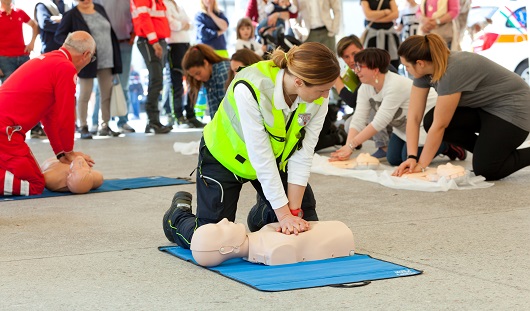Basic Life Support (BLS) is a crucial set of skills that enables individuals to provide immediate care and support to those experiencing life-threatening emergencies. This comprehensive online course, “Basic Life Support (BLS) Training,” is designed to equip participants with the knowledge and skills necessary to respond to cardiac and respiratory emergencies confidently.
In this course, you will learn the fundamental principles of BLS, including cardiopulmonary resuscitation (CPR), automated external defibrillator (AED) usage, and basic airway management. You’ll explore proper assessment techniques, the importance of early intervention, and strategies for effective teamwork in emergencies.
What you’ll learn:
Module 1: Introduction to Basic Life Support (BLS)
– Understanding the importance of BLS in emergency care
– Legal and ethical considerations in providing BLS
– The role of the rescuer in emergency response
Module 2: Recognition and Response to Cardiac Arrest
– Identifying signs of cardiac arrest and the chain of survival
– Performing high-quality CPR: chest compressions and rescue breaths
– Utilizing an automated external defibrillator (AED)
Module 3: Airway Management and Breathing Techniques
– Clearing obstructed airways: conscious and unconscious patients
– Providing rescue breaths using proper techniques and equipment
– Differentiating between adult, child, and infant BLS techniques
Module 4: Adult and Pediatric Choking Emergencies
– Recognizing and responding to choking in adults, children, and infants
– Performing abdominal thrusts (Heimlich maneuver) and chest thrusts
– Adjusting techniques for different age groups
Module 5: Special Considerations in BLS
– Providing BLS in special circumstances (e.g., drowning, electrocution)
– Considerations for pregnant individuals and individuals with disabilities
– Adapting BLS techniques for diverse populations
Module 6: Teamwork and Communication in Emergency Response
– Effective communication during emergencies
– Role clarity and coordination within a team
– Strategies for managing stress and maintaining composure
Module 7: Basic First Aid and Injury Management
– Assessing and managing common injuries and medical emergencies
– Control of bleeding, immobilization of fractures, and bandaging techniques
– Recognizing and responding to shock and allergic reactions
Module 8: BLS Certification and Continued Learning
– Preparing for BLS certification exams and requirements
– Resources and opportunities for continued learning and skills maintenance
– Personal and professional growth in emergency response
Career Path:
For individuals interested in pursuing a career in emergency response and healthcare, becoming an Emergency Medical Technician (EMT) can be a rewarding choice. EMTs are trained to provide immediate medical assistance in emergencies, including administering BLS and basic first aid.
To embark on a career as an EMT, consider the following steps:
1. Education and Certification:
– Complete the “Basic Life Support (BLS) Training” course (or similar programs) to acquire foundational BLS skills and knowledge.
– Enroll in an accredited EMT training program, which typically includes coursework and clinical experience.
– Obtain the required certifications based on your local jurisdiction, such as EMT-Basic or EMT-Intermediate.
2. Gain Experience:
– Seek opportunities to gain practical experience by volunteering with local emergency medical services (EMS) agencies, hospitals, or community organizations.
– Apply for internships or entry-level positions in healthcare settings to develop emergency response and patient care skills.
3. Obtain Licensure and Certifications:
– Pass the National Registry of Emergency Medical Technicians (NREMT) exam or the relevant certification exam for your region.
– Secure state or local licensure to practice as an EMT in your area.
4. Continuous Learning and Professional Development:
– Participate in ongoing training and continuing education to stay updated on the latest techniques, protocols, and medical advancements in emergency care.
– Pursue advanced certifications, such as Advanced Cardiac Life Support (ACLS) or Pediatric Advanced Life Support (PALS), to expand your skills and career prospects.
5. Gain Practical Experience:
– Work in various healthcare settings, including ambulance services, hospitals, clinics, or urgent care centers, to gain hands-on experience and exposure to different patient populations.
6. Specialize and Advance:
– Consider specializing in specific areas such as critical care transport, pediatric emergency care, or wilderness medicine.
– Pursue higher-level certifications or advanced degrees in paramedicine or emergency medical services management to advance your career.
